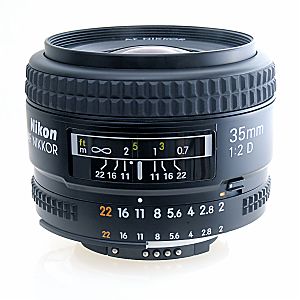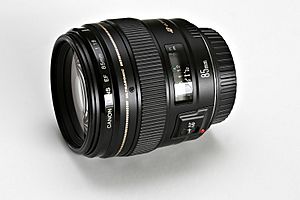Prime lens facts for kids

A prime lens is a special kind of camera lens that has a fixed "zoom" level. This means it can't zoom in or out like some other lenses. Because prime lenses are simpler to build (they don't have moving parts for zooming), they often have a wider opening called an aperture. A wider aperture lets in more light, which is great for taking pictures in dim places. They also usually take sharper, clearer photos than zoom lenses.
Contents
What is a Prime Lens?
A prime lens has a single, fixed focal length. Think of focal length as how "zoomed in" your camera is. For example, a 50mm prime lens will always show you the same view, like looking through a window that never changes size. You can't make the view bigger or smaller using the lens itself. If you want to get closer to your subject, you have to physically move closer!
Why Use a Fixed Lens?
You might wonder why photographers would choose a lens that can't zoom. There are a few good reasons:
- Better Quality: Because prime lenses are simpler, they can be made with fewer glass elements. This often means they produce sharper, clearer images with less distortion.
- Wider Aperture: Prime lenses usually have a much wider aperture than zoom lenses. The aperture is the opening that lets light into the camera. A wider aperture means:
* You can take photos in low light without needing a flash. * You can create a beautiful blurry background (called bokeh), making your subject stand out.
- Smaller and Lighter: Many prime lenses are smaller and lighter than zoom lenses. This makes them easier to carry around, especially if you're traveling or walking a lot.
- Creativity: Using a fixed lens can make you think more about your shot. Since you can't zoom, you have to move your body to frame the picture perfectly. This can help you become a better photographer!
Common Prime Lens Sizes
Prime lenses come in many different focal lengths, and each one is best for different types of photography:
- Wide-Angle Primes (e.g., 24mm, 35mm): These lenses capture a wide view, great for landscapes, architecture, or group photos where you want to fit a lot into the frame.
- Standard Primes (e.g., 50mm): A 50mm lens is often called a "nifty fifty" because it's very versatile. It gives a view similar to what the human eye sees, making it good for portraits, street photography, and everyday shots.
- Telephoto Primes (e.g., 85mm, 135mm): These lenses are designed to bring distant subjects closer. They are excellent for portraits because they create a very pleasing blurry background and help separate your subject from the surroundings. They are also used for sports or wildlife photography when you can't get close to the action.
Images for kids
See also
 In Spanish: Objetivo de distancia focal fija para niños
In Spanish: Objetivo de distancia focal fija para niños





